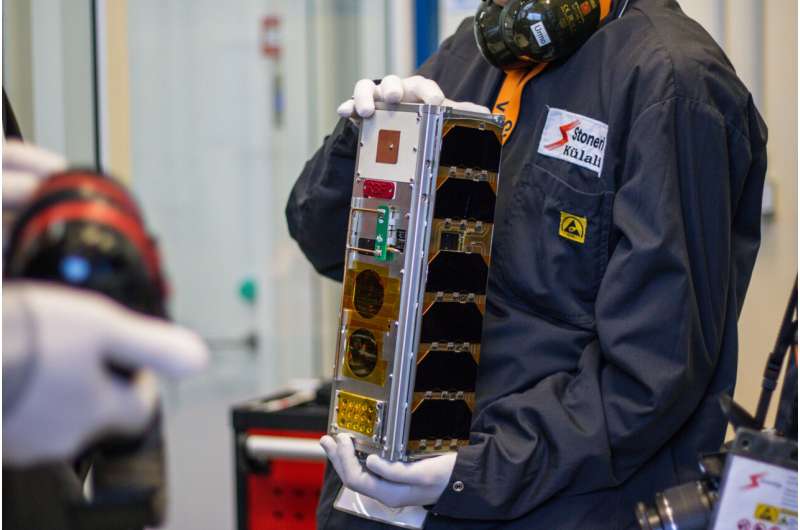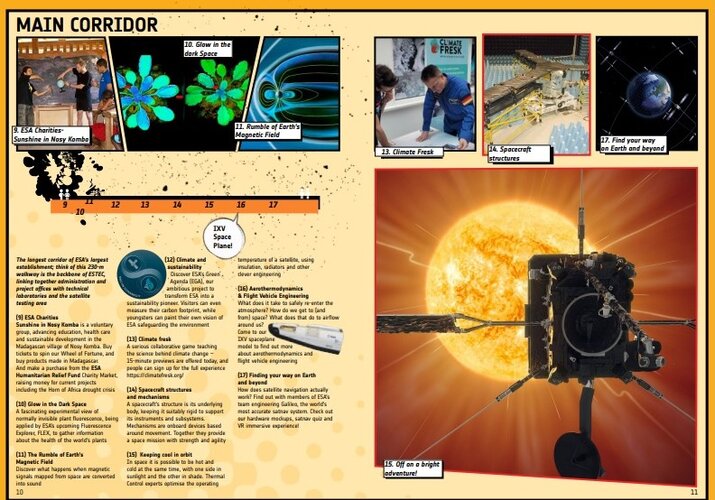
Copernical Team
Estonia's next satellite, largely built by undergrad students, to fly aboard Vega VV23

Estonia's next satellite will fly aboard Europe's Vega VV23 launcher later this week. While largely designed and built by undergraduate students, the shoebox-sized ESTCube-2 has ambitious goals in mind, including surveys of Estonian vegetation and the first successful in-orbit demonstration of "plasma brake" technology.
First spacewalk for Andreas Mogensen

ESA astronaut Andreas Mogensen will venture outside the International Space Station to install a new camera and prepare an experiment for a future upgrade on his first spacewalk on 12 October, starting at 16:00 CEST (15:00 BST).
Sunday’s ESA Open Day programme online

For all registered visitors for Sunday 8 October’s ESA Open Day at ESTEC in the Netherlands, the programme brochure for the day is now available to read through and plan your visit.
Researchers illuminate "Snowball Earth" melting and early life evolution
 A research team led by Prof. SHEN Yan'an from the University of Science and Technology of China (USTC) of the Chinese Academy of Sciences (CAS) conducted a systematic study of the interglacial stratigraphy in South China by means of high-precision sulphur and mercury isotope analyses. This study introduced a new perspective, suggesting that the melting of the "Snowball Earth" induced large-scale
A research team led by Prof. SHEN Yan'an from the University of Science and Technology of China (USTC) of the Chinese Academy of Sciences (CAS) conducted a systematic study of the interglacial stratigraphy in South China by means of high-precision sulphur and mercury isotope analyses. This study introduced a new perspective, suggesting that the melting of the "Snowball Earth" induced large-scale As Earth heats up, rain pours down
 Earth's land masses have a higher chance of becoming wetter than drier as temperatures rise. In a new study, researchers found that co-occurring precipitation and heat extremes will become more frequent, severe and widespread under climate change, more so than dry and hot conditions.
When wet-hot conditions strike, heat waves first dry out the soil and reduce its ability to absorb water. S
Earth's land masses have a higher chance of becoming wetter than drier as temperatures rise. In a new study, researchers found that co-occurring precipitation and heat extremes will become more frequent, severe and widespread under climate change, more so than dry and hot conditions.
When wet-hot conditions strike, heat waves first dry out the soil and reduce its ability to absorb water. S A newly identified virus emerges from the deep
 The Mariana Trench, the deepest place on Earth, plunges nearly 11,000 meters at its lowest point on the floor of the Pacific Ocean. Life persists in the deep and cold darkness, and "wherever there's life, you can bet there are regulators at work," said marine virologist Min Wang, Ph.D, at the Ocean University of China, in Qingdao. "Viruses, in this case."
This week in Microbiology Spectrum
The Mariana Trench, the deepest place on Earth, plunges nearly 11,000 meters at its lowest point on the floor of the Pacific Ocean. Life persists in the deep and cold darkness, and "wherever there's life, you can bet there are regulators at work," said marine virologist Min Wang, Ph.D, at the Ocean University of China, in Qingdao. "Viruses, in this case."
This week in Microbiology Spectrum Raisi: Nour 3 satellite launch another sign of sanctions' failure
 Iran's President Ebrahim Raisi has congratulated the nation on the successful launch of the Nour 3 imaging satellite into the space, describing the achievement as another sign of the failure of the sanctions and threats by the enemies of the Islamic Republic.
The president issued a message on Wednesday, hours after his Minister of Information and Communications Technology Issa Zarepour ann
Iran's President Ebrahim Raisi has congratulated the nation on the successful launch of the Nour 3 imaging satellite into the space, describing the achievement as another sign of the failure of the sanctions and threats by the enemies of the Islamic Republic.
The president issued a message on Wednesday, hours after his Minister of Information and Communications Technology Issa Zarepour ann Iran will launch two more satellites into space: IRGC cmdr
 A senior commander of the Islamic Revolution Guards Corps (IRGC) has announced that Iran will launch two more satellites into space by the end of the calendar year ending March 19.
Brigadier General Amir-Ali Hajizadeh, the commander of the IRGC's Aerospace Division, made the announcement on Wednesday following the successful launch of Nour-3, an imaging satellite, into orbit.
"Nour-3
A senior commander of the Islamic Revolution Guards Corps (IRGC) has announced that Iran will launch two more satellites into space by the end of the calendar year ending March 19.
Brigadier General Amir-Ali Hajizadeh, the commander of the IRGC's Aerospace Division, made the announcement on Wednesday following the successful launch of Nour-3, an imaging satellite, into orbit.
"Nour-3 BlueHalo expands US satellite operation capacity under Space Force SCAR Program
 BlueHalo recently hosted U.S. Space Force officials and federal legislative leaders for a successful milestone demonstration of its BADGER system, a multi-band, deployable ground terminal that enables resilient satellite communication.
This critical benchmark comes one year into development of the $1.4B Satellite Communication Augmentation Resource (SCAR) program announced by the Space Rap
BlueHalo recently hosted U.S. Space Force officials and federal legislative leaders for a successful milestone demonstration of its BADGER system, a multi-band, deployable ground terminal that enables resilient satellite communication.
This critical benchmark comes one year into development of the $1.4B Satellite Communication Augmentation Resource (SCAR) program announced by the Space Rap NASA will fly into Oct. eclipse's shadow
 A NASA sounding rocket mission will launch three rockets during the 2023 annular eclipse in October to study how the sudden drop in sunlight affects our upper atmosphere.
On Oct. 14, 2023, viewers of an annular solar eclipse in the Americas will experience the Sun dimming to 10% its normal brightness, leaving only a bright "ring of fire" of sunlight as the Moon eclipses the Sun. Those in t
A NASA sounding rocket mission will launch three rockets during the 2023 annular eclipse in October to study how the sudden drop in sunlight affects our upper atmosphere.
On Oct. 14, 2023, viewers of an annular solar eclipse in the Americas will experience the Sun dimming to 10% its normal brightness, leaving only a bright "ring of fire" of sunlight as the Moon eclipses the Sun. Those in t 